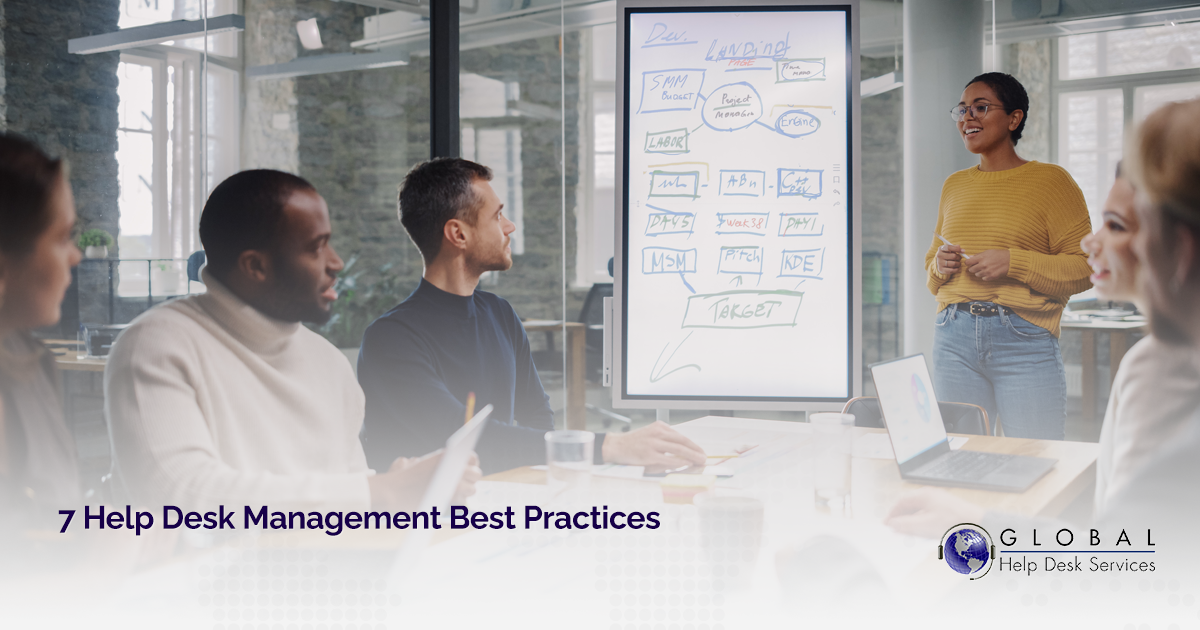Does your IT help desk want to boost customer satisfaction, reduce complaints, improve your reputation among external and internal stakeholders, increase ROI and generally win the day?
It may seem like a bit of a silly question, but it has a serious answer: Almost every goal your help desk has … starts with your help desk management.
Performance improvements must start at the top. And that means implementing some help desk management best practices. Here are the top things you should be doing to up your game.
Best Practice 1: Document Your Processes
One sign of an effective rowing crew is they all row in the same direction, at the same pace, with the same level of exertion. Help desk agents need to do the same, and the most effective way of getting consistent results from individual agents is to give them documented processes to follow.
Your agents need to know what to do in every possible situation. Make that easy for them by documenting the steps agents must take with callers for each known type of issue—and the steps to take with unknown issues.
Tips for effective process documentation
- Document processes that are predictable and repeatable
- Maintain a knowledge base that is easy to browse and quick to search
- Use help desk call scripts to document how your agents are to answer the phone, discover the issue behind each call, escalate tickets and more
- Ensure that your knowledge base is up to date by turning IT help desk tickets into knowledge base articles

Best Practice 2: Encourage Communication
The irony will likely not escape you: IT help desks, the folks who spend their days talking and emailing and chatting and texting, sometimes have a problem with communication.
They don’t have trouble communicating with users and customers. Their challenge is communicating among themselves, and with management.
The cure for infrequent communication is more communication, namely communication with a purpose.
Talk amongst yourselves
Start by encouraging inter-team communication: Get your agents talking with each other about what's going on. Provide regular opportunities for each agent to share with the other agents:
- What’s trending
- What’s working
- What’s not working
- New challenges
- New workarounds
- Better ways of using the knowledgebase
- Technical challenges in meeting user needs
- Better ways of communicating with users
- Anything else you can think of
Don’t keep agents in the dark
Next, encourage help desk supervisors and management to play a more active and vocal role in overseeing your help desk team. Agents who are kept in the dark long enough eventually disengage. Encourage communication and lead by example: Hold regular meetings to communicate strategic plans and progress with the help desk team.
Let’s chat!
Use meetings, Zoom calls, email, company intranet, group chats, help desk portals and other tools to ensure that the help desk agents regularly hear from management—and vice versa.
Chat groups are particularly effective at encouraging open communication. Keep chat groups open all day between teams and within teams so that everybody can talk with everybody. Chat groups help agents communicate what's happening in the moment so everyone is up to speed in real time.
In short, communicate, communicate, communicate. Know what your business needs are, and what your help desk’s needs are, and work hard to share those needs.
Best Practice 3: Grow Iteratively
Iteratively may seem like a buzzword, we admit. But it’s a smart way to grow.
Iterative growth is done in stages, and involves a cyclical process of tweaking the latest version (I.e., the latest iteration) of your help desk processes, based on data and results, to make a subsequent and better version.
Your goal as a help desk is to grow gradually. You should aim to avoid the delays, expenses and inefficiencies that come with poorly coordinated rapid growth. If you need to add five agents, for example, add them in stages, and document what you learn from each stage before deciding how to proceed next.
If you need to change three processes, change one at a time, and take what you learn with each change and apply it to the next one. Slow and steady (and based on solid information) wins the race.
Best Practice 4: Integrate Your Lines of Business
Some technical issues require the help of more than just your help desk agents to resolve. Once you have a clear picture of these issues and who in your organization is part of the solution, you are in a better position to resolve these support requests quickly and efficiently.
For example, let’s consider a virtual private network (VPN). It consists of the local software that runs on users’ computers and mobile devices.
Installing that software involves your help desk and your field services team. Also involved is your network team working behind the scenes to get the VPN up and running. You will also likely have a security group that's responsible for adding and removing user access to your VPN.
That’s four lines of business involved in keeping your users connected to your VPN and staying productive.
Your goal as a help desk is to integrate these four groups so you can handle all support calls that involve your VPN.
This will require a way to triage all calls, so support requests go to the right departments. Some support requests will require only the involvement of your help desk, for instance. Other requests might need your field services team, your network engineers or your security team. As you can see, the success of your help desk at resolving these support requests depends on the team’s knowledge of the layers of expertise in your organization. Get a clear picture of these people and the issues they solve, and you will deliver an exponentially better customer experience for your users.
Best Practice 5: Tie Ongoing Training to KPIs
In the help desk industry, there is no such thing as one-and-done. Hardware changes. Software changes. Ways of conducting business change. Customers and users change.
To keep up with a constantly changing environment, you must be constantly learning and training.
Ensure you deliver ongoing training in customer service skills to make sure your agents are using best practices in servicing your customers.
You should also base some of your ongoing training on issues you spot in your help desk metrics. Examine your reports to uncover trends in your first call resolution rates, average time on hold, average handle time, customer satisfaction scores, and any other metrics you’re tracking.
Then look for the drivers behind these trends. If you notice, for example, average handle time is creeping up, and if you discover the cause is agents skipping a vital early step in their calls, then deliver some remedial training to resolve this issue.
The key to improving agent performance is measurement following by training. You’re clearly and objectively identifying the issues, and then giving your team the tools they need to succeed. This is the kind of management that encourages IT help desk retention and lowers turnover.
Best Practice 6: Onboard Properly
Onboarding isn’t an HR function alone. For your new hires to be successful, they need a lot more than a guided tour of the office and some time to learn your company’s mission statement, payroll procedures and workplace health & safety guidelines. Effective help desk onboarding takes weeks, not days or hours—and it should look something like this:
Days 1 & 2
-
- Company tour
- Introduction to IT team
- Training on knowledge base and other applications
- Initial training on standard operating procedures
- Initial training on call scripts
- Compliance training
Weeks 1 & 2
-
- New hire shadows agent for a few days, listening in on calls and asking questions
- New hire answers support requests while agent shadows new hire, answering questions and offering help
Week 3
-
- New agents answer calls by themselves
- New agents use open group chat to ask questions
- Coaching on standard operating procedures continues
- Coaching on call scripts continues
Best Practice 7: Measure Performance
If you want to improve help desk agent performance, you must measure it. You can’t hit a target you can’t see. Start with the key performance indicators (KPIs) that give you the clearest picture of agent performance, namely:
- Customer Satisfaction Score
- First Call Resolution Rate
- Average Handle Time
- Call-to-Ticket Ratio
- Response Time
- Time to Resolve
- Cost Per Ticket
These KPIs and a few others indicate the success and failure of your help desk support operations … but only if you both measure them and monitor them. Gathering metrics is of no use unless you also monitor those metrics.
KPIs aren’t just something you add to a spreadsheet—they’re meant to be acted upon to add to your bottom line.
Better Help Desk Management = Better Help Desk Experience for All
As a help desk, you can never know what a day holds. Plenty of support requests will be commonplace and mundane. But others might just as well be uncommon and complex, maybe even bewildering.
Your team’s ability to resolve support tickets efficiently and cost-effectively depends on how many of these best practices you employ. Use all seven best practices and you will be on your way to delivering world-class help desk support.
Want to level up even more? Learn about the Top 10 Help Desk Challenges—and How to Overcome Them.




